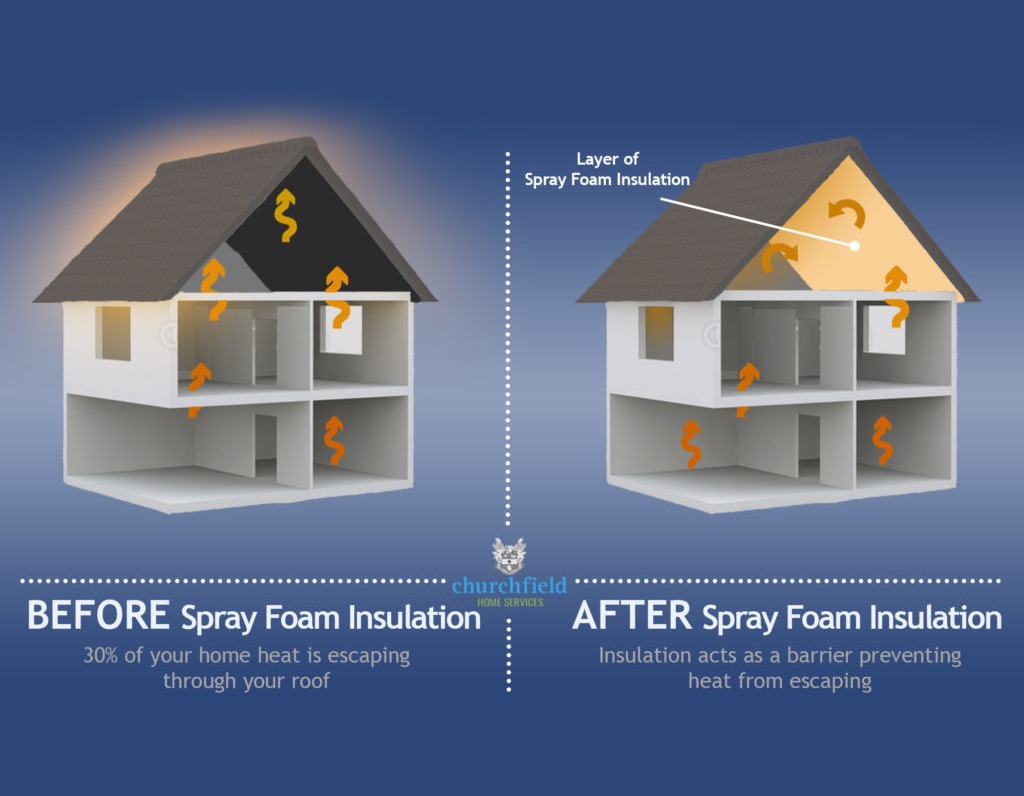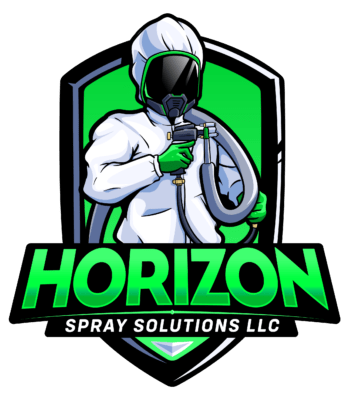What is your recommended R-Value?
Recommended Home Insulation R–Values
Insulation level are specified by R-Value. R-Value is a measure of insulation’s ability to resist heat traveling through it. The higher the R-Value the better the thermal performance of the insulation. The table below shows what levels of insulation are cost-effective for different climates and locations in the home.
Recommended insulation levels for retrofitting existing wood-framed buildings
Spray Insulation Solutions by Horizon Spray
Residential

Spray Foam products are extremely versatile. Manufacturers have optimized products to maximize performance in different areas of a home or building. Spray foam products can create an effective air barrier, form a continuous insulation system, and provide a barrier to moisture in the building envelope. Insulating and sealing your home with spray foam will limit drafts where it is applied and keep your home a consistent temperature all year long – making your home more comfortable. With spray foam, builders can lower construction costs, meet or exceed today’s stringent building code requirements, and provide customers with the benefits of spray foam.
Residential Benefits: Spray Foam as an Air Sealant
Air leaks can waste energy and drive up utility bills. Spray foam can weatherize your home by filling gaps and stopping the leaks in many areas of a home or building. Some common spots for air leaks that can be sealed with spray foam include:
- Behind knee walls
- Attic hatches
- Wiring holes
- Plumbing vents
- Open soffits
- Recessed light, furnace flue or duct chase ways
- Basement rim joists, windows and doors
Residential Roofing: Spray Foam Benefits
When it comes to the roof over your head, discover why you can count on spray polyurethane foam (SPF).
With a lifecycle performance that can exceed 30 years, SPF roofing systems offer quality that’s built to last. From high winds, rain, snow and hail to corrosion and foot traffic, SPF’s unique application process and adhesion properties help deliver long-term, high-performance results.
The Seamless Solution
SPF roofing systems are referred to as “self-flashing” because when properly applied, the durable foam conforms and adheres to a variety of shapes and substrates, forming a seamless, monolithic barrier.
Energy Efficiency
SPF roofs provide an insulating barrier for low slope and flat roofs for residential. SPF roofs can significantly reduce air leakage and heat transfer, saving energy otherwise used to heat and cool buildings and thus decreasing greenhouse gas emissions. SPF’s insulating properties make it one of the highest performers among roofing materials.
Additionally, “cool roofs” made with SPF reflect the sun’s energy which mitigates urban heat island effects and reduces building temperatures. Cool roofs help to minimize the effects of climate change because they reduce energy use and therefore certain emissions generated during energy production, and they decrease the heat trapped in the atmosphere by reflecting more sunlight back into space.
Comfort
Whether it’s a home or office building, strip mall or corner store, owners are concerned about building performance and energy efficiency. Spray foam can help builders provide long-term value to their customer. With spray foam, customers can enjoy the many benefits listed above and live in comfortable, draft-free homes or buildings.
The Spray Polyurethane Foam Alliance (SPFA) conducted a life cycle assessment of spray foam insulation. The results of the study show that the energy and environmental benefits from spray foam insulation used in new residential construction and commercial roofing retrofits far outweigh the embodied energy and embodied environmental impacts.
Spray foam is an excellent way to provide energy reductions to customers as well as improve the overall quality of a home and or building.
Energy Efficient: As much as 40% of a building’s energy is lost due to air infiltration. Gaps, holes and air leaks—which can all be prevented—can make energy bills unnecessarily high and let valuable resources go to waste. Spray foam offers a solution: it weatherizes your home acting as both insulation and an air sealant, or air barrier, closing those nooks and crannies that let air escape and increase monthly energy bills. The U.S. Environmental Protection Agency’s (EPA) Energy Star program estimates that by adding insulation and sealing air leaks, you could save up to 20% on your monthly energy bills.
The U.S. Department of Energy estimates that 56% of the energy used in a home goes to heating and cooling.
Commercial

Spray foam is different. It allows an architect to use one product for many purposes: to achieve an air barrier, vapor barrier and provide effective insulation. Spray foam can provide you with a cost-effective building design and energy efficient building performance.
Spray foam is an excellent way that you can incorporate energy reductions into your building design. The Spray Polyurethane Foam Alliance (SPFA) conducted a life cycle assessment of spray foam insulation. The results of the study show that the energy and environmental benefits from spray foam insulation used in new residential construction and commercial roofing retrofits far outweigh the embodied energy and embodied environmental impacts.
What does that mean for the roof over your head?
Reduced ponding due to unique roof designs and various application thicknesses to create a positive slope and improve drainage.
Reduced leakage due to coverage around seams, penetrations, parapet walls, HVAC curves, vents and skylights.
Polyurethane foam roofs eliminate the need for counter flashing.
A Better Solution
Roofs made with SPF can provide long-term quality, while also decreasing potential impacts to the environment by reducing resource expenditures and minimizing the use of landfill capacity. SPF roofs are valued for their energy efficiency, a performance quality which helps minimize the environmental impact of buildings.
Reroof, Recycle and Reduce
When considering a roof, it is important to think about the repair process if it is damaged. SPF roofs do not typically have to be removed during repair, unlike many other roofing systems. Because SPF roofing systems adhere to the substrate, if damaged they resist lateral movement of water which reduces the size of the repair. Once the damage is identified, the area can usually be re-foamed without having to remove the roof.
SPF roof systems can also be applied on top of existing materials on most low slope or flat roofs without the need for tear-off, which extends a roof’s life. These attributes simplify repairs, reduce waste in landfills, and reduce repair time compared to some other replacement techniques.
Commercial Benefits:
Designing with Spray Foam
Prevention: Spray foam helps control moisture. Open- and closed-cell spray foam can act as a moisture vapor barrier. In addition, sealing gaps and air leaks can prevent humidity and condensation within a building. Spray foam also helps prevent mold. By controlling moisture, spray foam can limit one of the key variables that can lead to mold growth.
Durability: Spray foam makes buildings more durable. Fewer moisture problems result in a more durable building. Also, medium density, closed-cell spray foam can be used to make wall assemblies stronger by increasing their racking strength.
Flexibility: Spray foam provides design flexibility. Spray foam expands to fill cavities, crevices, and gaps –even awkward or difficult to reach areas—allowing you to be creative with your design.
Commercial Roofing: Spray Foam Roofs
Spray Foam Roofs: Strong and Durable
Constructing with spray foam can help make commercial structures stronger, more resilient, and mitigate repair costs after climate and other natural disasters.Applying a spray foam roofing system can improve a building’s strength, with an effective lifespan that can exceed 30 years.
Because spray foam conforms and adheres to the surface on which it is sprayed, a strong bond forms to protect the roof. The layer of spray foam is seamless and self-flashing, which can eliminate the ability of water to seep through weak spots, such as fasteners and seams.
FEMA: Has classified SPF insulation as highly resistant!
Spray Foam Insulation: Strength and Resilience
The Federal Emergency Management Agency (FEMA), which responds to natural disasters, has classified SPF insulation as highly resistant to floodwater damage, saying, “These materials can survive wetting and drying and may be successfully cleaned after a flood to render them free of most harmful pollutants.
Applying closed-cell spray foam in the cavities of the walls increases durability of the wall system because of the foam’s ability to conform and adhere to the surface upon which it is sprayed. A wall with spray foam insulation has a higher racking strength, or ability to maintain its shape under duress, than a wall assembly without spray foam.
Applying closed-cell spray foam to the underside of the roof deck can increase the wind-resistance of your roof by up to 2.5 times. Using closed-cell spray foam can help keep your roof deck in place during high wind events.
HOW DOES IT WORK?
Spray Foam Insulation is quickly becoming the preferred solution for new construction and retrofit projects alike. Designed to effectively fill cracks and crevices, SPF is applied quickly and cures within seconds. It is mold resistant, permanent and provides a “custom fit” insulation solution unique to each structure because it is easily applied to awkward spaces, such as around pipes, crawl spaces, roof peaks, attics and walls.
Even older homes and buildings can benefit from spray foam insulation. With slow-rise SPF installed in external walls and the correct spray foam in the attic, drafty old houses can become more energy efficient by today’s standards. Plus, existing HVAC units and duct work will function in a less demanding “conditioned” environment, potentially extending the life of this expensive equipment.
-
OPEN CELL:
Less Expensive Per Inch
Creates sound barrier
R-Value of 3.5 to 3.7 per inch
Reduces Noise Transmission
Interior Walls and Rafters
-
CLOSED CELL:
Creates an air tight barrier
R-value of 6 to 6.5 per/inch
Metal buildings, attics and exterior walls.
Adds strength and rigidity for improved structural integrity.
Reduces noise transmission
Moisture and vapor barrier

Spray Foam Insulation for Commercial Buildings Brings long-term cost savings
Spray foam insulation is an investment that will usually outlast the life of the building. In other words, it is pretty much a one-time cost that continues to function for many, many years. To add to this, it is extremely low maintenance, meaning that you do not have to spend that much time, effort, and money, ensuring that the fixture is in tip-top condition.
When you pair this with the previous benefit of monthly savings the installation pretty much pays itself off quickly.
Energy Efficient
New Building Codes
States and localities continue to adopt codes that encourage or mandate increased energy efficiency. Spray foam can help you meet or exceed stringent building and energy codes.
Spray foam is an air barrier. Effective air barriers are now an integral part of building codes and standards, and they can increase the efficiency of mechanical systems, which could allow for additional savings in reduced HVAC requirements.
Incorporating spray foam in your building design can help you achieve LEED certification or NAHB Green Building certification.
Some jurisdictions may offer tax credits, rebates, grants, or other incentives for architects and building designers who include SPF in their building designs.
Spray Foam Insulation for Commercial Buildings Improves Energy Efficiency
When it comes to energy efficiency, we talk about the R-value of different materials such as walls and ceilings. The higher the value, the more energy-efficient it is. That is because a higher number means that less water or air can penetrate a particular surface.
Now, spray foam has an R-value of around 5.3. To put that into perspective, concrete is about 1, depending on a few other factors. As you can see, spray foam is an extremely effective insulation material. That is because, once it hardens, it creates an energy-efficient environment.
In turn, this lets your HVAC system not perform as hard, helping you save money while still maintaining a cozy atmosphere.
Key Advantages of Commercial Spray Foam Roofing
Unless you want to pay lofty energy bills and spend your days either shivering or sweating, insulating your commercial space is essential—especially the roof of the building, where a significant amount of heat is lost. When it comes to choosing what type of insulation to install on your commercial building’s roof, spray foam insulation should top your list. If you’re unfamiliar, spray foam roofing essentially refers to a roofing service that involves spraying a liquid blend of polyol resin and some form of isocyanate onto a roof. This mixture will then expand to cover the roof completely before hardening and creating an airtight seal. If you’re not sure if this insulation material is right for your space, taking a look at these key advantages of commercial spray foam roofing might just change your mind.
All of our service levels include
Social Media Profiles
Areas Served
Kramer, Pleasant Dale, Sprague, Pleasant Hill, Centerville, Milford, Wilber, Emerald
Hoag, Plymouth, Syracuse, Lincoln, McCool Junction
And many others - use the quick question form below to ask if we serve your area:
